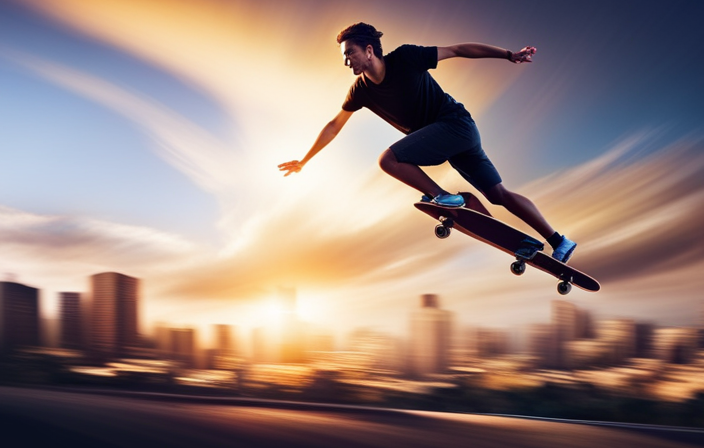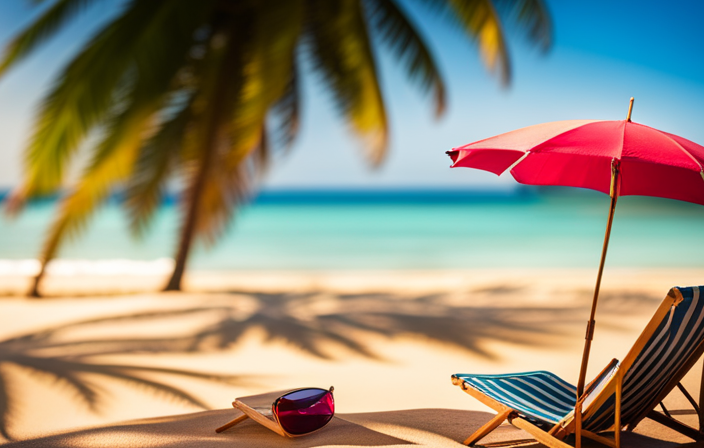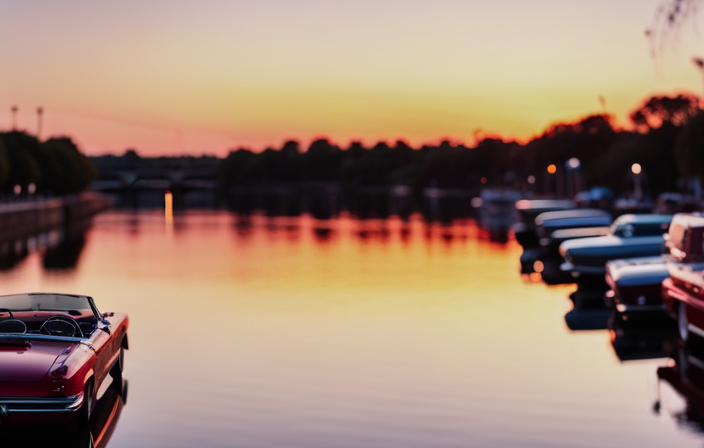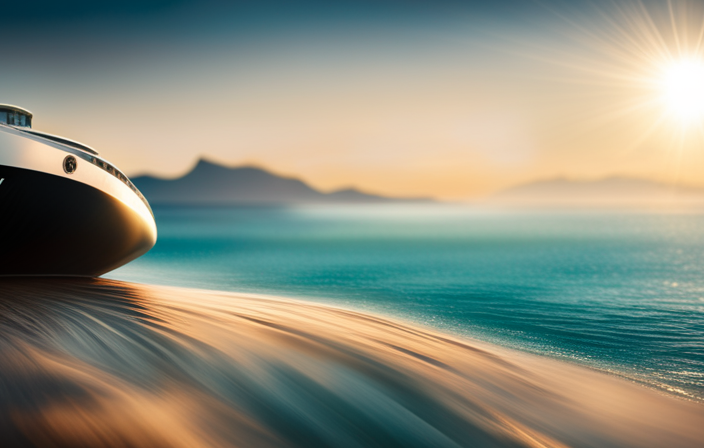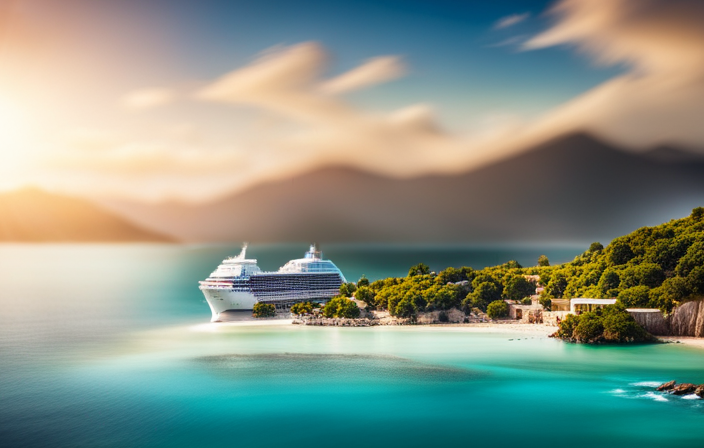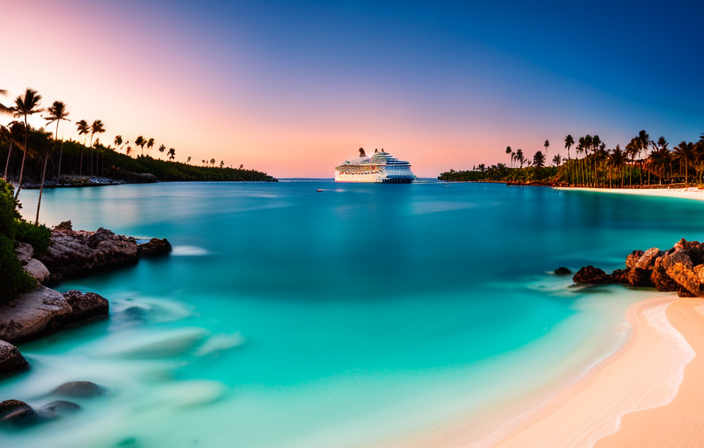Are you excited to cruise the streets and feel the breeze in your hair? Look no further, as I am here to provide you with the ultimate guide for skateboarding adventures.
Whether you’re a beginner or a seasoned skater, this article has got you covered. From choosing the right skateboard to mastering your balance and stance, we’ll walk you through every step of the way.
With tips on pushing, turning, and even braking, you’ll be gliding effortlessly in no time. We’ll also cover riding on different surfaces and how to stay safe with the right gear and precautions.
And if you’re feeling adventurous, we’ll even dive into some advanced techniques and tricks. So grab your board, strap on your helmet, and get ready to cruise like a pro.
Let’s roll!
Key Takeaways
- Techniques for navigating cracks and bumps: Distribute weight evenly, Bend knees, Lift front wheels to avoid getting caught
- Navigating potholes: Approach at an angle, Be cautious of gravel, Adjust speed
- Riding on different surfaces: Adjust riding style, Maintain lower center of gravity, Distribute weight evenly
- Importance of safety gear and precautions: Prioritize safety, Wear helmet, knee pads, elbow pads, wrist guards
Choosing the Right Skateboard
When choosing the right skateboard, it’s like finding the perfect partner to dance with on the smooth concrete streets. To truly master skateboard tricks and enjoy the ride, it is crucial to find the perfect skateboard size.
A skateboard that’s too small or too big can affect your balance and make it difficult to perform tricks or cruise comfortably. The size of the skateboard deck depends on your height and shoe size. Generally, a deck width between 7.5 to 8.5 inches is suitable for most riders. It provides a good balance between stability and maneuverability.
Additionally, consider the wheelbase and truck width to ensure the right fit for your riding style.
Now that you’ve chosen the perfect skateboard, let’s move on to mastering your balance and stance.
Mastering Your Balance and Stance
Find your feet planted firmly on the board, toes gripping the edge like a tightrope walker clinging to their balancing pole. Mastering balance is essential when cruising on a skateboard. It’s all about finding that sweet spot where you feel stable and in control.
Start by keeping your weight centered over the board, distributing it evenly between your front and back foot. This will help you maintain stability and prevent wobbling. As you gain confidence, you can experiment with different stances to find what works best for you. Try widening your stance or bending your knees slightly to improve stability.
Remember to relax and let your body flow with the board’s movements. By mastering your balance and improving stability, you’ll be ready to tackle the next step: pushing and foot placement.
Pushing and Foot Placement
Get ready to feel the exhilaration as you push off and place your feet just right on the board. Proper foot positioning and weight distribution are key to cruising on a skateboard. Here are some tips to help you master this crucial skill:
- Place your front foot perpendicular to the direction of travel, with your toes slightly angled towards the nose of the board.
- Position your back foot diagonally across the tail, with your toes hanging off the edge slightly.
Keep most of your weight on your front foot, while still maintaining some pressure on your back foot. Use your pushing foot to generate momentum by pushing off the ground and transferring your weight onto the board.
By following these techniques, you’ll be able to push off and maintain balance as you cruise along.
Now, let’s dive into the next section and learn how to turn and carve with confidence.
Turning and Carving
Mastering the art of turning and carving on a skateboard is like dancing on wheels, effortlessly gliding through the streets.
To execute smooth and controlled turns, it’s essential to understand the proper carving techniques and body positioning. When initiating a turn, you want to shift your weight onto your toes or heels, depending on the direction you want to go. This will allow you to lean into the turn and maintain stability.
As you carve, focus on bending your knees to absorb any bumps or obstacles on the road. By maintaining a low center of gravity, you’ll have better control over your board. Remember to keep your upper body relaxed and use your arms to help with balance.
As we transition into the next section about braking and slowing down, it’s important to note that these skills go hand in hand with turning and carving, allowing you to navigate your skateboard with confidence and finesse.
Braking and Slowing Down
When it comes to braking and slowing down on a skateboard, there are a few different methods I’ve found to be effective.
One way is to use the foot brake, where you drag your back foot on the ground to create friction and slow yourself down.
Another method is to use a slide, where you shift your weight and slide the wheels sideways to slow down.
It’s important to practice these techniques in a safe area and gradually build up your confidence and skill level.
Different methods for braking
To slow down on a skateboard, simply lean back and press gently on the tail with your foot, allowing the friction between the wheels and the ground to gradually bring you to a stop. This method is effective for everyday braking situations and can be used in emergency braking scenarios as well.
However, it’s important to note that in emergency situations, relying solely on this method may not provide enough stopping power. That’s where sliding techniques come into play. Sliding involves intentionally breaking traction with the ground by shifting your weight and applying pressure to the edges of the board. This allows for more control and quicker stops.
Sliding techniques require practice and should be approached with caution. Mastering these techniques will enhance your ability to slow down safely on a skateboard and improve your overall riding experience.
Slowing down safely on a skateboard
If you want to put the brakes on your ride, just lean back and gently tap the tail of your board, letting the wheels do the talking as they kiss the pavement.
Slowing down safely on a skateboard is crucial, especially in emergency braking situations or when navigating steep hills. Here are a couple of methods to slow down effectively:
-
Foot Braking: Extend one foot slightly and place it on the ground, using the sole of your shoe as a brake pad. Gradually apply pressure to slow down.
-
Powersliding: This advanced technique involves turning the skateboard sideways and sliding the wheels to create friction with the pavement. This allows for controlled deceleration.
Slowing down on a skateboard requires practice, balance, and finesse. Once you’ve mastered this skill, you’ll be better equipped to navigate obstacles seamlessly.
Now, let’s move on to the next section about navigating obstacles.
Navigating Obstacles
When approaching curbs and ramps on a skateboard, it’s important to maintain a steady speed and keep your body balanced.
I find it helpful to slightly lift the front of the board as I approach the obstacle, using my back foot to provide a little extra lift.
To navigate cracks and bumps, I use a technique called ‘ollieing’ where I pop the tail of the board down and jump, allowing the wheels to clear the obstacle.
It’s crucial to keep your knees bent and your weight centered to maintain control and minimize the impact of the uneven surface.
Approaching curbs and ramps
As you cruise on your skateboard, confidently navigate curbs and ramps, effortlessly gliding over obstacles with style and precision. Approaching rails and ledges, jumping and ollieing on a skateboard are essential skills to conquer curbs and ramps. Mastering these techniques will allow you to seamlessly transition from the smooth surface to the elevated obstacle. When approaching a curb or ramp, keep in mind the following table:
| Approach | Execution | Landing |
|---|---|---|
| Speed | Pop and slide | Absorb impact |
| Eyes forward | Level out | Bend knees |
| Commitment | Extend legs | Roll away smoothly |
Approach the curb or ramp with enough speed to generate momentum. As you near the obstacle, pop the tail of your skateboard and slide your front foot up to level out the board. Extend your legs to absorb the impact upon landing and remember to bend your knees. As you roll away smoothly, maintain your focus and look ahead to anticipate the next challenge. With these techniques in mind, you’ll be ready to tackle the next section about navigating cracks and bumps seamlessly.
Techniques for navigating cracks and bumps
To smoothly navigate cracks and bumps, you’ll need to utilize specific techniques that allow you to maintain balance and control.
When approaching cracks, it’s important to distribute your weight evenly on both feet to minimize the impact. Bend your knees slightly and use your legs as shock absorbers. As you encounter a crack, lift your front wheels slightly to avoid getting caught and losing momentum.
When it comes to navigating potholes, it’s best to approach them at an angle. This allows you to roll over them smoothly and reduces the risk of getting stuck. Additionally, be cautious of gravel on the road as it can cause your wheels to slip. Adjust your speed accordingly and try to avoid it whenever possible.
Now, let’s move on to riding on different surfaces and exploring new challenges.
Riding on Different Surfaces
When riding on different surfaces, it’s important to adjust your riding style accordingly. For rough or slippery terrain, I’ve found that maintaining a lower center of gravity helps to provide more stability and control.
Additionally, it’s crucial to keep your weight evenly distributed on the board to prevent any unexpected slips or slides.
By adapting your riding technique to different surfaces, you can confidently navigate any obstacle that comes your way.
Adjusting your riding style for different surfaces
Shift your weight and bend your knees to adjust your riding style for various surfaces while cruising on a skateboard. When riding on different surfaces, such as smooth pavement or rough terrain, it’s crucial to adapt your technique to ensure you can maintain control and adjust your speed accordingly.
On smooth surfaces, you can shift your weight slightly forward to increase your speed, while bending your knees helps absorb any vibrations and maintain stability.
When encountering rough or slippery terrain, it’s important to shift your weight back to maintain balance and control, while keeping your knees slightly bent to absorb any bumps.
By adjusting your riding style to match the surface you’re on, you can have a smoother and more enjoyable cruising experience.
Now, let’s delve into some tips for riding on rough or slippery terrain.
Tips for riding on rough or slippery terrain
Navigate through rough or slippery terrain with finesse, like a seasoned surfer gracefully riding the waves. When cruising downhill, it’s crucial to maintain control and stability. Keep your weight centered over the board, bending your knees slightly to absorb any bumps.
To maintain traction on wet surfaces, choose a skateboard with grippy wheels that have a softer durometer. This will provide better grip and prevent sliding. Additionally, adjust your riding style by using wider turns and reducing your speed to avoid losing control.
When encountering rough terrain, adopt a looser stance to allow for more flexibility and better balance. Remember to keep your eyes focused ahead to anticipate obstacles and adjust your riding accordingly.
By following these tips for downhill cruising and riding on wet surfaces, you’ll be able to navigate challenging terrain with confidence and skill.
Now, let’s move on to discussing the importance of safety gear and precautions.
Safety Gear and Precautions
When it comes to riding a skateboard, it’s crucial to prioritize safety by choosing the right protective gear. This includes wearing a helmet, knee pads, elbow pads, and wrist guards to prevent injuries in case of falls or accidents.
Additionally, practicing safe riding habits such as maintaining control, being aware of your surroundings, and following traffic rules will further reduce the risk of accidents.
Choosing the right protective gear
Equip yourself with the right protective gear like a skateboard helmet, knee pads, and elbow pads to ensure a safe and worry-free cruising experience on your skateboard.
These protective gears are essential as they provide a layer of protection in case of falls or accidents. A skateboard helmet is crucial to protect your head from any potential injuries. It should fit snugly on your head and have proper ventilation to keep you comfortable.
Knee pads are essential as they protect your knees from scrapes, bruises, and more serious injuries. Look for knee pads that are sturdy, well-padded, and fit securely around your knees.
Once you have chosen the right protective gear, you can then focus on practicing safe riding habits, such as maintaining a proper stance and learning how to control your speed effectively.
Practicing safe riding habits
To ensure a smooth and enjoyable ride, it’s important to develop good habits that prioritize safety and control. Choosing the right helmet is crucial for protecting your head from potential injuries. Look for a helmet that meets safety standards and fits comfortably. Additionally, proper skateboard maintenance is essential for safe riding. Regularly check your skateboard for any loose bolts, worn-out wheels, or damaged bearings. Keeping your board in good condition will help prevent accidents caused by equipment failure.
| Skateboard Safety Tips | |
|---|---|
| 1. Always wear a helmet | 4. Be aware of your surroundings |
| 2. Check your skateboard for any damage | 5. Practice proper foot positioning |
| 3. Learn to fall correctly |
By following these safety guidelines and maintaining your skateboard, you’ll be better equipped to handle advanced techniques and tricks in the next section. Remember, safety should always be a top priority when cruising on a skateboard.
Advanced Techniques and Tricks
Get ready to feel the thrill as you master advanced techniques and tricks while cruising on your skateboard! Once you’ve built a solid foundation of basic riding skills, it’s time to take things to the next level.
Advanced tricks such as kickflips, heelflips, and 360 flips will add excitement to your sessions. These tricks require precise foot placement, quick flicks of the ankle, and a good sense of timing.
As you become more comfortable with these advanced tricks, you can start exploring skatepark maneuvers. Try dropping into ramps, grinding on rails, and launching off of ramps for some airtime.
Remember to always wear protective gear and start with smaller obstacles before attempting more challenging ones.
Now, let’s dive into the next section where we’ll discuss maintaining and upgrading your skateboard.
Maintaining and Upgrading Your Skateboard
Keep your skateboard in top shape by regularly maintaining and upgrading it to ensure a smooth and thrilling ride. When it comes to maintaining your skateboard, one important aspect is upgrading the trucks. Upgrading your skateboard trucks can greatly enhance your riding experience. Look for trucks that are durable, lightweight, and provide good turning capabilities. Upgraded trucks can improve stability, control, and overall performance. Another key aspect of maintenance is taking care of your skateboard bearings. Bearings are essential for a smooth ride, and regular cleaning and lubricating can help extend their lifespan. Use a skate tool to remove the bearings, clean them with a solvent, and then lubricate them with skateboard-specific oil or grease. Proper maintenance and upgrades will keep your skateboard performing at its best and ensure an enjoyable cruising experience.
| Upgrading Skateboard Trucks | Maintaining Skateboard Bearings |
|---|---|
| Durable | Regular cleaning |
| Lightweight | Lubricating |
| Good turning capabilities | Skate-specific oil or grease |
Frequently Asked Questions
How do I choose the right size of skateboard wheels for cruising?
To choose the right size of skateboard wheels for cruising, consider the diameter. Bigger wheels (55-60mm) provide more speed and stability, while smaller wheels (50-54mm) offer better maneuverability. Skateboard wheels are typically made of polyurethane, providing durability and grip.
What is the best way to practice balancing on a skateboard before cruising?
To practice balancing on a skateboard, start with simple exercises like standing on the board and shifting your weight from side to side. Experiment with different stances to find the one that feels most comfortable and stable.
How do I avoid getting speed wobbles while cruising downhill?
To avoid speed wobbles while cruising downhill, it’s crucial to find the right skateboard deck for cruising. I once had speed wobbles on a flimsy deck, but after upgrading to a sturdier one, they disappeared completely.
Can I use the same foot placement for pushing and cruising on a skateboard?
Yes, you can use the same foot placement for pushing and cruising on a skateboard. For proper body positioning while cruising, keep your weight centered over the board and your feet parallel to the trucks.
Are there any specific techniques for navigating potholes and cracks while cruising on a skateboard?
Maneuvering around obstacles while cruising on a skateboard requires anticipating potholes and cracks. To maintain stability on rough terrain, keep your knees bent, use your arms for balance, and shift your weight as needed.
Conclusion
So there you have it, folks! Cruising on a skateboard may seem like a breeze, but it takes time and practice to truly master.
From choosing the right skateboard to mastering your balance and stance, there are numerous factors to consider. But fear not, because with the right techniques and a dash of determination, you’ll be cruising through the streets like a pro in no time.
Just remember to stay safe, wear your safety gear, and always be aware of your surroundings. Now go out there and shred those pavements!
Claire, a creative soul with an unquenchable thirst for storytelling, is an integral part of the Voyager Info team. As a dedicated writer, she weaves captivating narratives that transport readers to enchanting cruise destinations and beyond.
Claire’s love affair with writing began at an early age when she discovered the magic of words and their ability to craft worlds and emotions. Her innate curiosity led her to explore various literary genres, but it was travel writing that truly captured her heart. Drawing inspiration from her own globetrotting adventures and encounters with diverse cultures, Claire embarked on a journey to become a travel writer par excellence.

